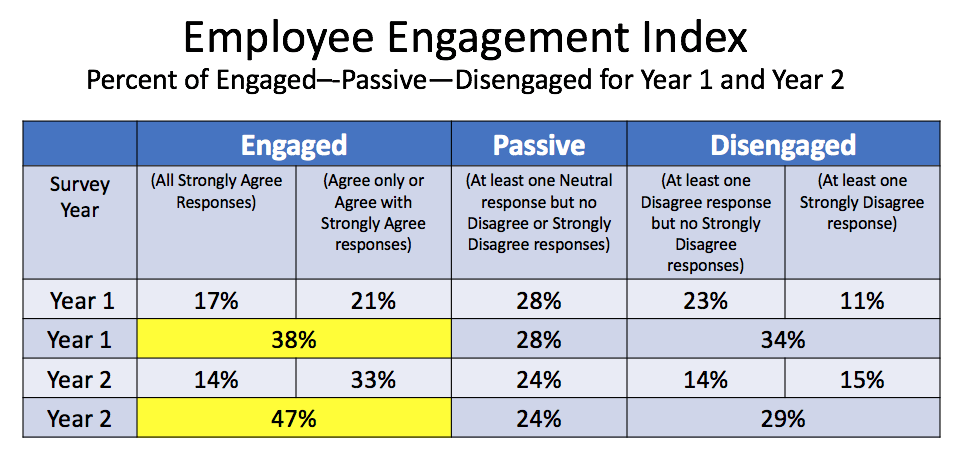Use an Employee Engagement Index to monitor engagement.
Do you compute an Employee Engagement Index? Certainly, you measure employee engagement. But do you have a metric to monitor change in engagement year-by-year?
In an employee engagement survey, you have items to determine a) the Level of Engagement of employees and b) the Drivers of Engagement.
- Level of Engagement items tend to measure, firstly, the condition of engagement and secondly, the outcomes of engagement. To clarify, the condition of engagement is the presence of cognitive, emotional and physical energy. And, outcomes of engagement are intending to stay with and advocacy for the company.
- Next, you have additional items on the survey that focus on the Drivers of Engagement. With these questions, you can collect information to guide action planning. Most importantly, action planning targets the key drivers of engagement identified in the survey results.
Did engagement go up or down?
Some clients ask for their engagement score to use as a barometer. They want to compare employee engagement over the years. In other words, if you ask the same survey questions, year-after-year, then isn’t there a way to show change? Is there some formula to use to show whether employee engagement is going up or down? This metric could be called the Employee Engagement Index.
Options for computing an Employee Engagement Index
Below are a couple of options you can use to create an Employee Engagement Index.
If you are interested in a more detailed review of options for Employee Engagement Metrics, go to this link for a page on my website dedicated to explaining Employee Engagement Metrics.
Now for two options for an Employee Engagement Index:
Engagement Index: Option 1
One way to calculate the engagement index is to compute three numbers. These numbers are 1) percent engaged, 2) percent responsive to engagement, and 3) percent disengaged. To clarify, you can compute these numbers this way:
- Engaged: percent who give top two box responses to the Level of Engagement questions. To clarify, see the numbers in yellow in the image below.
- All positive responses–Strongly Agree and/or Agree
- No Neutral response
- No negative responses–Disagree and/or Strongly Disagree
- Responsive to Engagement (Passive): percent of employees who give top three box responses to the Level of Engagement questions. That is to say, there is at least one Neutral response but no negative responses.
- Disengaged: percent of employees who give at least one bottom two box response to the Level of Engagement questions. In other words, there is at least one negative response–Disagree and/or Strongly Disagree.
The three numbers–% Engaged, % Passive, and % Disengaged–provide metrics to monitor change over the years. For example, just highlighting the percent Engaged from year-to-year is a useful metric for your Employee Engagement Index. For example, in the table above, engagement increased 9% from Year 1 to Year 2.
Engagement Index: Option 2
Another option for creating the engagement index is to compute a mean percent favorable score for each section of the survey and monitor changes in those scores, year-by-year. To clarify, this method generates a number of scores to monitor. This works best if the company is targeting a particular driver of engagement area—like Fit, Trust, Caring, Communication, Achievement or Ownership. And if they want to monitor if the changes they have made since the last survey are having an impact.
Calculate scores for all sections—not just one or two sections. Changes in one area can have an impact on other areas. Also, monitor the key driver questions to see if targeted items (within the sections) have changed. These mean percent favorable scores for each area are your metrics. To sum up, use these metrics to monitor changes in engagement from year-to-year.
In addition, for a Slideshare presentation on this topic, go to this link.
Contact Sheila to help you improve employee engagement
To sum up, contact Sheila to help your organization improve employee engagement. To clarify, her management consulting firm Workplace Culture Institute is based in Atlanta, serving clients globally.
Above all, use the Contact Form to email Sheila.
RAQUEL D. MARTIREZ Posted on 11:05 am - March 5, 2016
Good day! I am currently doing my Masteral Thesis related to Employee Engagement in a workplace. I would like to ask your kind assistance and permission for me to use your survey as on of my tools on my study. Hoping to hear from you soon since i will be needing to finish my research before the 15th of month of April this year. Thank you and more power .
Leave a Reply
Cancel reply
Leave a Reply
This site uses Akismet to reduce spam. Learn how your comment data is processed.

1 comment so far